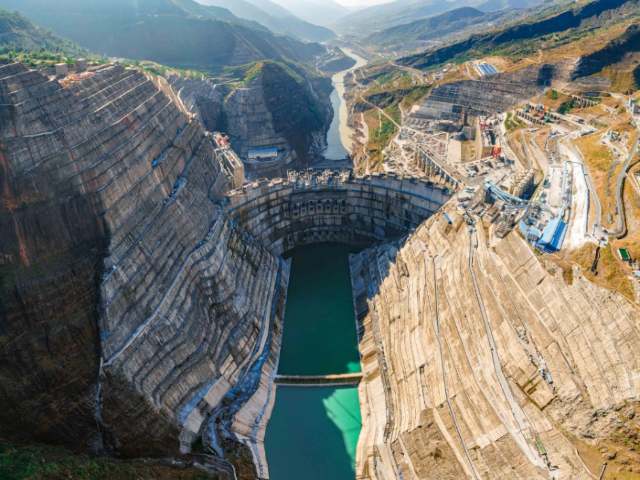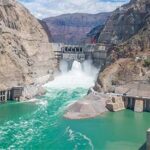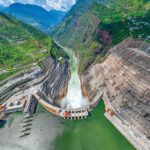A new 16-GW hydropower project in China and a 9-GW plant in Indonesia are among several projects being highlighted as part of Global Hydropower Day, being celebrated Oct. 11 as the hydro sector notes the importance of the technology to the world’s power generation.
The Baihetan Hydropower Station in China is being developed by Jinsha River Chuanyun Hydropower Development Co., a joint venture among China Three Gorges (CTG), Sichuan Energy Investment Group, and Yunnan Energy Investment Group. The Baihetan plant is being built on the Jinsha River, a tributary of the Yangtze River in southwest China. It would be the world’s second-largest hydroelectric dam in terms of generation capacity, behind only the 22.5-GW Three Gorges Dam in China, upon completion.
Executives from Indonesian power company Kayan Hydro Energy (KHE) last week said the group plans to start commercial operation of the first 900-MW unit of the eventual 9-GW Kayan Cascade plant in 2026. Officials said the site on the island of Borneo is under development, with construction of a dam diversion channel scheduled to begin next year. Andrew Suryali, KHE’s chief executive, said the project will represent an investment of $17.8 billion. KHE is developing the project in partnership with Japan’s Sumitomo Corp.
Want to learn more about hydropower? The International Hydropower Association’s “The Power of Water” video series provides stunning visuals and a look at how hydro is important for decarbonization.
“While much of the attention is rightly on scaling up wind and solar, hydropower is the world’s largest source of renewable energy, generating around 16% of the world’s electricity—almost as much as wind and solar combined,” said Eddie Rich, CEO of the International Hydropower Association (IHA). Rich told POWER, “As a dispatchable solution, [hydropower] is the only clean technology that can provide the flexible backup needed to enable wind and solar at the scale needed to meet net-zero targets. According to forecasts published last year by the International Energy Agency, we will need to double global hydropower capacity by 2050 in order to limit global temperature rises to 1.5°C.”
Rich said, “Alarmingly, we are still seeing hydropower left out of the conversation” when it comes to decarbonization of the energy sector. “We will need to harness the complementary strengths of all renewables if we are to make net-zero goals a reality. That’s why we are working with progressive organizations around the world on Global Hydropower Day to highlight the immense benefits of hydropower to society when it is developed responsibly.”
Baihetan Units Already Online
The Baihetan project extends over Ningnan County in the Sichuan province, and Qiaojia County in the Yunnan province, in China. Several of the project’s units already are online; the first two of the plant’s 1-GW turbines were commissioned in June of last year. The last of the 16 turbines was installed in May of this year, and each unit is expected to be operational by year-end.
Baihetan is the latest large-scale hydro project from CTG, the group behind the 10.2-GW Wudongde Hydropower Station, chosen as POWER’s Plant of the Year earlier this year.
A contract-signing ceremony for the Kayan Cascade project was held in Jakarta, Indonesia, on Oct. 6. Airlangga Hartarto, Indonesia’s Coordinating Minister for the Economy, said the hydropower plant is part of Indonesia’s commitment to achieve a net-zero emissions from the power sector goal by 2060. The minister said the government is targeting for nearly a quarter of all power generation in Indonesia to come from renewable energy no later than 2026.
Leading Source of Renewable Energy
Officials from the hydropower sector in promoting Global Hydropower Day note that more than 60% of all renewable electricity worldwide is generated by hydro. The technology is responsible for about 16% of the world’s total power generation from all sources. A variety of physical and virtual hydropower-related events are being held across the globe Tuesday, part of an ongoing “We can, with hydropower” campaign to highlight the benefits of hydroelectricity.

Organizers of Global Hydropower Day told POWER that more than 2 million people worldwide are employed in the hydro sector. They are touting the benefits of the technology, including “providing clean, affordable electricity generation and energy security for grids increasingly reliant on fast-growing solar and wind power. Wider benefits include supporting the decarbonization of industries, as well as protecting communities through providing water management infrastructure.”
The campaign is led and spearheaded by the IHA, with support from a coalition of developers, operators, manufacturers, and industry associations worldwide.
“Hydropower has provided a reliable, flexible, and long-lasting source of energy for more than a century,” said Rich. “It has enabled economies around the world to flourish and standards of living to grow. But we don’t often hear about the human benefits of hydropower. Sustainable hydropower is a clean, green, modern, and affordable energy source. But it does far more than simply provide power. Whenever governments have backed hydropower development, it has brought jobs, social investment, water supply, flood and drought management, irrigation for food and ecotourism.”
Impact of Drought
Drought conditions are limiting hydropower output in many areas, including across the western U.S., with significant impacts in California. Countries such as Brazil and China, home to several of the world’s largest hydropower dams, also are being challenged by drought.
The National Oceanic and Atmospheric Administration (NOAA) in an August 2022 report said, “The persistent excessive heat increased evaporative demand which, when combined with below-normal precipitation, made drought conditions worse from Spain to Germany and from the British Isles to the Balkans.”
Rich told POWER: “It’s funny and tragic that few notice how much we rely on hydropower until it is in danger of not being there. Widespread droughts in 2022 are a wake-up call to governments that we need to invest in our infrastructure today to protect tomorrow’s generations from the devastating effects of climate change. Hydropower is a unique energy source in that it provides a whole range of non-power services to society. Crucially, in the context of climate change, this includes the ability to manage our increasingly scarce water resources such as providing flood control and drought mitigation.
“The governments whose electricity systems are most resilient to extreme weather events are those that have invested in building, upgrading and modernizing their hydropower assets,” Rich said. “There is also a need to improve transmission infrastructure to enable better interconnectivity between regions that are affected by climate change in different ways. Hydropower is the solution to drought, not the problem. The only way we can keep global temperature rises under control is by accelerating hydropower development to support the growth of variable renewables like wind and solar.”
—Darrell Proctor is a senior associate editor for POWER (@POWERmagazine).










